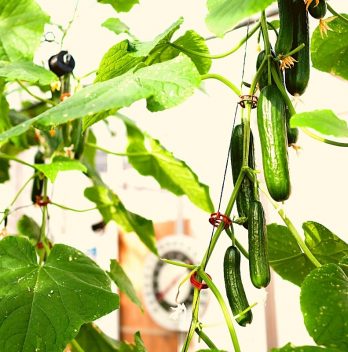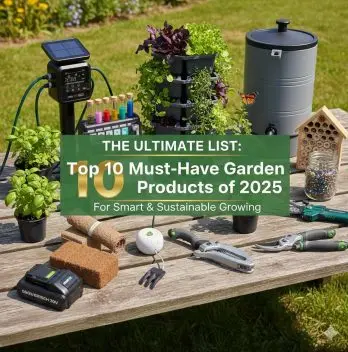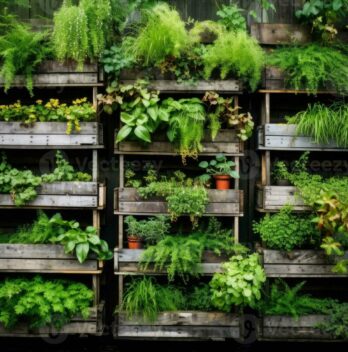Let’s talk about the hydroponic cucumber nutrient formula. One common vine crop that is popular among farmers and gardeners is the cucumber plant. It is loved for the juicy and delicious fruits that it produces.
Hydroponic cucumbers can be grown successfully in a greenhouse setting. They are pretty easy to cultivate and they will yield fast and great results. Getting the hydroponic nutrient formula right for hydroponic cucumbers is crucial as this will provide sufficient nutrients for the plants to support all stages of their growth cycle.
Read on to learn about how to start cucumber hydroponics and the hydroponic cucumber nutrient formula requirements.
Select The Variety Of Your Choice
There are over 100 varieties of cucumbers to choose from. Some of these varieties can be easily found in supermarkets, while others are more uncommon and can only be found in specialty shops. These cucumbers can be used in various ways in the kitchen, such as pickling, slicing for salads, sandwiches, or just snacking.
Eight of the most common cucumbers are;
- English cucumbers
- Persian cucumbers
- White cucumbers
- Garden cucumbers
- Kirby cucumbers
- Lemon cucumbers
- Armenian cucumbers
- Gherkins
Some varieties are better suited for certain functions, so we that recommend you select the variety based on your preference or purpose. Choose if you want to cultivate cucumber for pickling or slicing. You should also select the variety based on your hydroponic setup. There are also resistant cucumber varieties which are an excellent choice. Note that these varieties can come in various shapes, sizes, and maturation lengths of time.

Other characteristics differentiate them. These may be useful to know if you plan to grow them:
- Burpless: this type of cucumber variety tastes more delicious. It is also thin-skinned.
- Spineless: this type does not have a spine or any prickly stubs. It also has smooth skin.
- Bitter-free: most cucumbers are known to taste bitter when ignored and left for a long time on the vine. However, this type of cucumber variety is made to be bitter-free.
- Gynoecious Cucumber: this type gives rise to female flowers. Some gynoecious cucumber varieties do not require pollination, while some do. Both however produce large numbers of flowers and will produce a lot of cucumber fruit over a relatively short period.
Hydroponic Cucumber Nutrient Formula
A balanced hydroponic cucumber nutrient formula has the right formula to support the growth of the plants at whatever stage it is at. To make a nutrient solution for cucumbers in a hydroponic medium, this is how you should do it;
Materials Needed
Plastic container, expanded clay, net pots, and hydroponic cucumber nutrient formula.
Starting Hydroponic Cucumber Seedlings
Started hydroponic cucumber in 3 ways, and they are:
- Seed Germination: start with cucumber seed germination. The seeds will germinate quickly and you start to notice seedlings within 3 to 10 days.
- Soil Transplant: you can as well transplant cucumber plants from
soil to a hydroponics medium. You can purchase some cucumber plants from a garden store near you and transplant them into your hydroponics. - Cloning: start hydroponic cucumber with cloning as this is another great method. You can be assured of getting results of the same features or traits from the plants you used for cloning.
Type Of Hydroponic System To Choose
You need to decide which type of hydroponic will suit your cucumber. Variety is also important when choosing the type of hydroponic for your cucumber plant.
Indoor hydroponics will require space. But if you don’t have much space you can go for the bushy cucumber variety. You can go for the deepwater culture or ebb and flow system for indoor hydroponics.
We would however recommend you grow cucumber outdoors in the warmer months. This way, they can have adequate space and there will be space to produce more yield. You can make use of vertical hydroponics by training them to grow vertically. You can also opt for the drip, Dutch bucket, and bug ebb and flow systems. Use a trellis for support when your cucumber plants start to grow big.
Hydroponic Cucumber Nutrient Formula Requirements
Hydroponic cucumber nutrients have a specific formula. This is especially meant for their vegetative development. You can easily purchase these nutrient solutions online as they are readily available.
There are some nutrient solutions readily available to usher your cucumber plant into its flowering stage. Other nutrient solutions are also available to gear your cucumber plant throughout its flowering stage. Note for the flowering stage, you are required to change your nutrient scheme to lesser nitrogen. Also, add more potassium and phosphorous.
The one type of general nutrient scheme may be simple to use. But know that they may not provide your cucumber plants with the required nutrients tailored for the specific growth phase. Along with the right nutrient formula for your hydroponic cucumbers, other crucial environmental conditions should be maintained at an optimal range for efficient growth and production. These are;
- pH – water pH for hydroponic cucumbers is key to efficient growth. The ideal pH range that the system should be kept at is between 5.5 – 6.0
- Temperature – cucumber plants will thrive well in temperatures ranging from 70 to 80 degrees Fahrenheit. This temperature range will encourage and boost the growth of your cucumber plant.
So, your cucumber should be ready after 5 to 6 weeks after seed sowing.
Common Hydroponic Cucumber Problems
While growing cucumbers in hydroponics systems can be quite a breeze compared to growing them in the
1. Powdery Mildew
Powdery mildew is a white fungus that can grow on the leaves, flowers, and fruits of the cucumber. This fungus thrives in areas that have a warm climate and provide high humidity. Environments like greenhouses are breeding grounds for powdery mildew, so if your hydroponics system is in a greenhouse your cucumbers are at high risk of getting infected. The risk will be higher in the summer and spring months.
Powdery mildew will not directly kill your cucumbers but it will steal some of the nutrients and water that the cucumber was supposed to use for growth and productivity. This will result in your cucumber plants growing slowly, becoming weak, or not even producing fruit.
The best way to treat powdery mildew is with the use of an organic fungicide that has sulfur as the main active ingredient.
Homemade remedies are another option to try. Mixtures that include potassium carbonate, soap, milk, and water work well. You could also add Neem oil to these mixtures for additional fungus-killing power.
2. Gummy Stem Blight
Gummy stem blight is another fungus that infects the stem and leaves of the cucumber plant and causes wet black lesions on the leaves and causes the stems to split and ooze a reddish brown sticky substance. If it is left untreated, the blight can travel up to the fruit and cause it to develop into black rot, resulting in the loss of a potentially good crop.
Commercial fungicides with great strength are used to treat gummy stem bight. They are applied during the prime gummy stem blight season, or when the leaves of the cucumber plant are starting to reach their full size.
3. Two Spotted Spider Mites
Two-spotted spider mites thrive in hot and dry environments. They can negatively affect the growth and productivity of cucumbers by interfering with photosynthesis.
The spider mites paper has tiny spots on the bottom of the leaves that cause them to swell, turn yellow, develop signs of necrosis, and reduced the growth of plant leaves.
If your cucumber plant is affected by these mites, the outer skin of the fruit will become rough and have a texture like that of sandpaper.
The spread of two-spotted spider mites is best controlled as soon as possible because they have very fast growth and multiplication rates, especially if the conditions are optimal for their breeding and growth.
Apply miticides or scrub the cucumber plant leaves with insecticide soap to get rid of them. You could also introduce predatory mite species that will kill the spider mites but not harm the cucumber plants.
4. Broad Mites
Broad mites feed and lay their eggs on the bottom of cucumber leaves. When infected, the shoots of the plant become distorted, the leaves begin to curl downward, and the fruits crack.
Broad mites thrive and reproduce in hot, humid conditions. They can however still reproduce and spread in cooler conditions, although at a slower rate. These mites can also spread via plant-to-plant contact, tools, and the gardener’s hands if they have come into contact with infected plants.
The application of miticides may help to a certain extent, but broad mites are resistant to most of these chemicals. The best way to deal with them is to remove all the infected plants in the garden. Also, make sure that you always clean and sanitize all the tools that you use in the garden after each use so that the spider mites do not spread.
How Long Does It Take To Grow Cucumbers Hydroponically?
After germination, cucumber plants grow very fast if the right environmental conditions are provided for them. It takes between four and six weeks from when the seed is sown to when the first cucumber is ready to pick. Cucumbers will continue to produce for three to four months after they start. To always have a cucumber crop, you can practice sequential planting
Can You Grow Cucumbers In Hydroponics?
Cucumbers are one of the most commonly grown plants in hydroponics due to the ease with which they can be grown. They can be grown as a hobby and they are also grown in hydroponics commercially.
They are best grown in greenhouses where conditions can be manipulated to suit the growth stage of the plant. Cucumbers grow best in warm temperatures of between 75 and 85 degrees F, and high light. Cooler temperatures and low light can limit the growth of cucumbers in hydroponics.
Final Note -Hydroponic Cucumber Nutrient Formula
With that said, we hope you’ve learned some things about growing cucumber hydroponically. Ensure you follow all our tips on hydroponic cucumber nutrient formula to get the best and most productive cucumber crop. Happy growing!
FAQ’s
What nutrients do hydroponic cucumbers need?
The term hydroponic cucumber refers to the fact that you do not have to provide any soil or manure for the plants to grow in. Instead, you supply the plant with a nutrient solution that they will absorb through their roots. Hydroponic cucumbers are grown in small plastic trays that are placed on top of a water source.
This is done because the water is recirculated, which prevents the growth of algae and other bacteria that could grow in soil-based cucumbers. The nutrient solution provides all the minerals and nutrients that the cucumber needs to grow. The nutrients that are used in hydroponic cucumber growing are called macro and micro nutrients. Macro nutrients are nutrients that are needed by the plant to grow. They include nitrogen, phosphorous, potassium, calcium, magnesium, boron, zinc, copper, manganese and iron. These nutrients are not as available in the soil as they are in the water. Micro nutrients are nutrients that are needed by the plant to grow but are not part of the macro nutrients. They include chlorine, copper, iron, manganese, molybdenum and zinc.
What is the best nutrient solution for hydroponics?
There are many nutrient solutions available to growers for hydroponics. However, most of these are not as efficient as they should be. There are many factors to consider when choosing a hydroponic nutrient solution, such as: Sugar content – The sugar content of the nutrient solution is very important, especially for those with high-intensity light. If the sugar content is too high, it can have an effect on photosynthesis and transpiration rates in plants. It can also have a negative effect on plant growth and development. Too low of a sugar content can result in low photosynthetic rates, plant stress, and even death. The best solution would have about 5-10% sugar. Mg/L – Magnesium is necessary for healthy cell division and chlorophyll production in plants. It is also beneficial for root hair growth. It is also essential to reduce the amount of calcium in the soil. Ca/L – Calcium is an essential mineral that is needed by plants for optimal health. Ca is the main component of cell walls, which helps with the strength and integrity of the plant. Calcium also helps promote strong cell walls, which will help the plant grow faster and thicker. K/L – Potassium is a vital element for plant growth and development. It is required for the formation of carbohydrates and proteins, as well as maintaining the cellular membrane. K is also essential to prevent plants from becoming salt-sensitive. Sulfate/L – Sulfate is an important nutrient for plants that is necessary for healthy cell division, chlorophyll production, and root hair growth. It is also essential for healthy plant growth and development. A good sulfate/L ratio is around The pH level of the nutrient solution is extremely important. A proper pH level is required for plants to properly absorb nutrients. Osmolarity – Osmolarity is a measure of the amount of dissolved solids in a solution. This number is used as a measure of the osmotic pressure of the solution. Osmolarity can be measured with an osmometer. It is important to keep the osmolarity of the nutrient solution at around 300-400 mOsm. This will help prevent the accumulation of excess salts and minerals in the soil or nutrient solution, which can be detrimental to plant growth. Dissolved Oxygen – Dissolved oxygen is one of the most important elements to consider when creating a nutrient solution for hydroponics. Too much oxygen can cause plant stress, and too little oxygen can cause plant death. A good dissolved oxygen level is around 7-10 mg/L.

Eunice is an enthusiastic gardener with a passion for growing beautiful flowers. She loves nothing more than spending time in her garden, tending to her plants and enjoying the outdoors. Eunice has been gardening for over 15 years and has developed a unique style of landscaping that is both practical and aesthetically pleasing. She is especially fond of growing roses and enjoys experimenting with different varieties and colors. Eunice takes great pride in her garden and often shares the fruits of her labor with friends and family. In her spare time, she enjoys reading gardening magazines and attending local horticulture events. Eunice is passionate about her hobby and is always eager to share her knowledge and experience with others.





